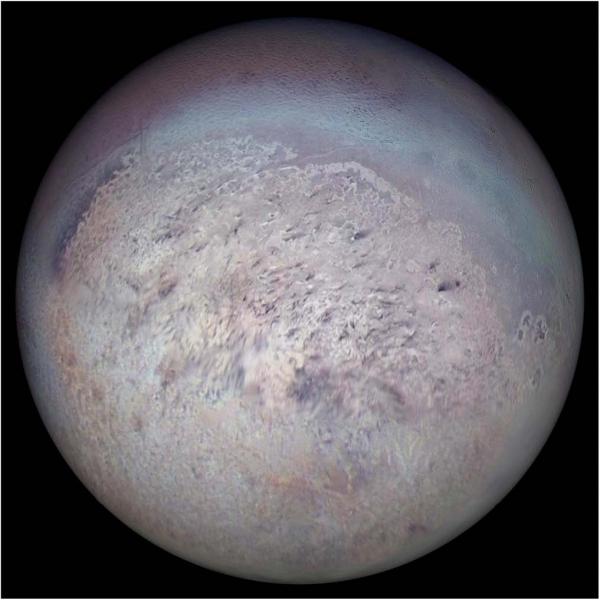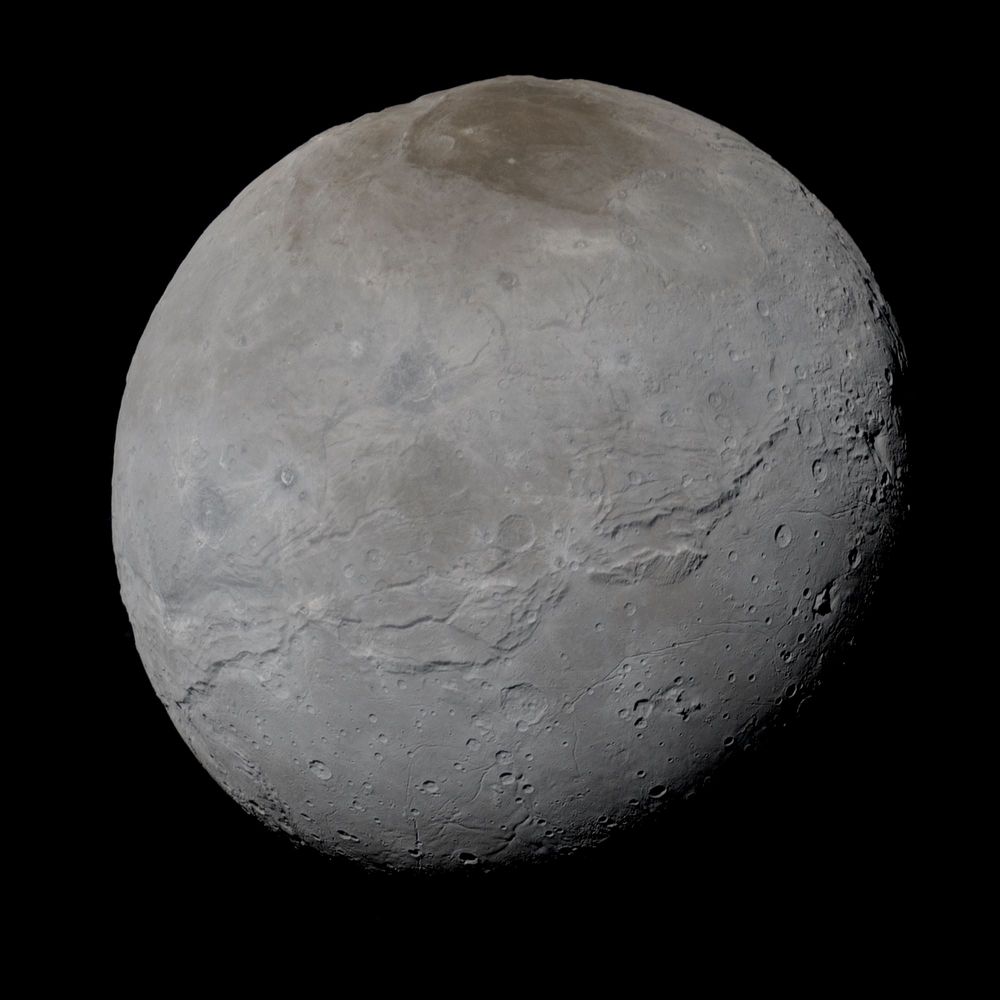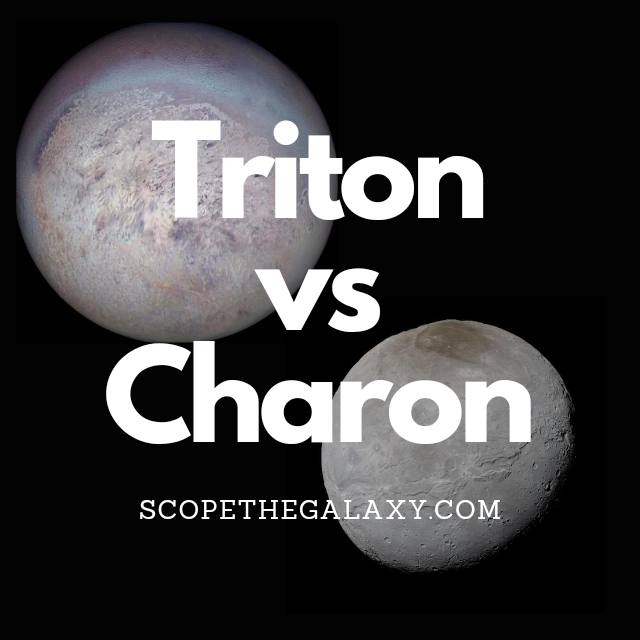*This post may contain affiliate links. This means we may make a commission if you purchase an item using one of our links*
The main differences between Triton and Charon is that Triton is far bigger with a diameter of 2,706km whilst Charon has a diameter of 1,212km, Triton has a thin a atmosphere whilst Charon has practically no atmosphere, Triton orbits Neptune whilst Charon orbits Pluto and Triton has a retrograde orbit whilst Charon does not.
There are a number of other differences between the two so, continue reading for a more detailed look at both natural satellite’s along with their similar and unique features below.
What Is The Moon Triton?
Table of Contents

Triton is the largest moon of Neptune, whose most unusual feature is its retrograde orbit. Triton is the only major moon in our solar system which orbits in the opposite direction of its planet’s rotation.
First discovered on 10th October 1846 (just 17 days after the discovery of its planet, Neptune) by British astronomer William Lassell, “Triton” comes from a merman in Greek myth; a name which perhaps stems from the composition of this faraway moon.
The diameter of Triton is approximately 2,706km, making it a similar size to Earth’s moon. However, we know that its mass is far less than the first estimates suggested because data from Voyager showed that the surface is icy and highly reflective, a less dense composition than the dark surface of our moon.
This icy surface has resulted in ice based natural satellite displaying temperatures in the region of – 235 degrees Celsius.
This lower density stems predominantly from the water-ice interior encasing a denser rock core. Still, the mean density of 2.06 grams per cubic cm remains higher than that of any of Saturn’s or Uranus’ moons. In addition, Triton holds more than 99.5% of the mass of everything that orbits the planet Neptune and its total mass is greater than every smaller satellite in the solar system combined.
Scientists think that Triton may be an object from the Kuiper Belt that Neptune’s gravity captured millions of years ago. This is because it shares many similarities with the dwarf planet Pluto – the best-known world within the Kuiper Belt.
This frozen world is a land of geological oddities with craters and a collection of depressions and ridges known as cantaloupe terrain. The geysers found on this moon shoot plumes of nitrogen as high as 8km high, which creates a thin atmosphere of nitrogen.
In around 3.5 billion years, Triton’s orbit will travel too close to Neptune, and the planet’s gravitational pull will break the moon apart, creating a ring system.
What Is The Moon Charon?

Charon is the largest of Pluto’s moons, first discovered on 22nd June 1978. The surface of this icy world is frozen with nitrogen and methane ice; it may also hold some water ice. While Pluto possesses a reddish hue, Charon is closer to a neutral shade of grey; this suggests the two bodies have different compositions.
Scientists named this moon after the mythical ferryman, Charon, who once carried souls across the Acheron river. This river is one of five legendary rivers that could lie beneath the surface of Pluto.
The formation of Charon remains something of a mystery to scientists. However, this moon may have formed around 4.5 billion years ago when an object traveling at immense speed collided with Pluto. Its average distance from the Sun is approximately 3.6 billion km.
Charon is almost half the size of its planet at 1,212km, where scientists refer to these two bodies as a “double dwarf planet system,” and the chilly temperatures vary from minus 23 to minus 258 degrees Celsius.
Charon takes 153 hours to orbit its planet at an average distance of 19,640km, and it is tidally locked, meaning the same side of the moon always faces Pluto. Pluto also experiences a tidal lock to Charon, so the same two sides always face one another.
Among the fascinating features of this ice moon are the ice volcanoes that could exist on the surface. Observations from the Gemini observatory suggest that Charon could have a form of cryovolcanism known as ice-particle geysers.
The frigid world also has a canyon between seven and nine kilometers deep. (To put that into perspective, Mount Everest has a height of 8.8km).
Similarities Between Triton And Charon
As both are natural satellites, Charon and Titan do share a few similarities, which includes the following:
- Both have a hotter central core.
- Both have a rocky, terrestrial surface.
- Both are spherical in shape.
- Neither have rings surrounding them.
- Both are tidally locked to their planet.
- Both orbit their planet in an elliptical pattern.
- Neither have a magnetic field.
- Neither have tectonic plates.
Differences Between Triton And Charon
In regards to the differences between the two, they include the below:
- Charon is smaller with a diameter of 1,212km whilst Triton has a diameter of 2,706km.
- Triton orbits Neptune whilst Charon orbits Pluto.
- Triton has a very thin exosphere composed mostly of nitrogen with small amounts of methane whilst Charon’s has practically no atmosphere.
- A day on Triton takes 5.877 days whilst a Charon day is 153 hours.
- It takes Triton 5.877 days to orbit Neptune whilst Charon orbits Pluto in around 153 hours.
- Charon orbits Pluto at an average distance of 19,640km whilst Triton is 354,800km from Neptune.
- Triton’s average temperature is around -235 degrees Celsius whilst Charon’s average temperature is -23 to -258 degrees Celsius.
- Charon’s density is 1.71 g/cm³ whilst Triton’s density is 2.06 g/cm³.
- Charon mass is 1.58 × 10^21 kg whilst Triton’s mass is 2.14 × 10^22 kg.
- Triton’s gravitational strength is 0.779 m/s² whilst Charon’s is 0.288 m/s².
- Triton is the only moon in our solar system that orbits its planet in a retrograde orbit.
Summary
Both Charon and Triton are natural satellites, are tidally locked to their respective planets and are rock based however, they are still unique when you breakdown their features
Whether it be in regards to their mass, size, gravitational strength, how they orbit their respective planets and more, Triton and Charon are still very distinct celestial bodies in their own right.

